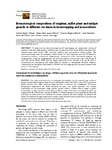Please use this identifier to cite or link to this item:
http://www.alice.cnptia.embrapa.br/alice/handle/doc/968519| Title: | Bromatological composition of shorghum, millet plant and midget-guandu at different cut times in intercropping and monoculture. |
| Authors: | TIRITAN, C. S.  SANTOS, D. H.   MINUTTI, C. R.   FOLONI, J. S. S.   CALONEGO, J. C   |
| Affiliation: | CARLOS SÉRGIO TIRITAN, UNOESTE; DIEGO HENRIQUES SANTOS, Companhia de Desenvolvimento Agrícola de São Paulo; CLÁUDIA REGINA MINUTTI, UNOESTE; JOSÉ SALVADOR SIMONETI FOLONI, CNPSO; JULIANO CARLOS CALONEGO, UNOESTE. |
| Date Issued: | 2013 |
| Citation: | Acta Scientiarum. Agronomy, Maringá, v. 35, p. 183-190, 2013. |
| Description: | Abstract: To determine the chemical composition of intercropping and monoculture cultivars of sorghum, millet and midget-guandu, we determined the production of dry matter (DM), ashes, gross fiber, ethereal extract, gross protein (GP), nutritious digestive total, and extractive without oxygen. The experimental design used was completely random blocks with four repetitions split into 18 treatments: monoculture sorghum, monoculture midget-guandu, monoculture millet, intercropping sorghum and midget-guandu, millet and midget-guandu and millet and sorghum, with cutting times at 30, 60 and 90 days after sowing (DAS). Millet had the highest production of dry biomass at 30 and 60 DAS in monoculture and intercropping. The highest DM was obtained by intercropping (90 DAS). Sorghum intercropping had the highest crude protein at 30 DAS, and the midget-guandu promoted increased crude protein at intercropping. Resumo: Com objetivo de determinar a composição bromatológica dos cultivares de sorgo, milheto eguandu, consorciados e solteiros, determinou-se produção de matéria seca (MS), cinzas, fibra bruta, extratoetéreo, proteína bruta (PB), nutrientes digestivos totais e extrativos não nitrogenados. Utilizou-se delineamento experimental em blocos completos ao acaso, com quatro repetições, com parcelas subdivididas em 18 tratamentos: sorgo solteiro, guandu solteiro, milheto solteiro, sorgo e guandu consorciados, milheto e guandu consorciados e milheto e sorgo consorciados, com épocas de corte nos estágios de 30, 60 e 90 dias após a semeadura (DAS). O milheto apresentou a maior produção de MS aos 30 e 60 DAS no monocultivo e em consórcio. Os maiores valores de MS foram obtidos no consórcio (90 DAS). Os consórcios de sorgo apresentaram maiores valores de proteína bruta aos 30 DAS e o guandu-anão promoveu aumento de proteína bruta no cultivo consorciado. |
| Keywords: | Monocultivo |
| ISSN: | 1807-8621 |
| DOI: | 10.4025/actasciagron.v35i2.15772 |
| Type of Material: | Artigo de periódico |
| Access: | openAccess |
| Appears in Collections: | Artigo em periódico indexado (CNPSO)  |
Files in This Item:
| File | Description | Size | Format | |
|---|---|---|---|---|
| Bromatologiacalcompositionofshorghummilletplantandmidgetguanduatdifferentcuttimesinintercroppingandmonoculture.pdf | 585.25 kB | Adobe PDF |  View/Open |









